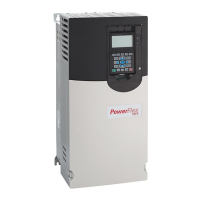1-2 Getting Started
PowerFlex® 755 Drive Embedded EtherNet/IP Adapter User Manual
Publication 750COM-UM001A-EN-P
Features
The features of the embedded EtherNet/IP adapter include:
• Switches to set an IP address before applying power to the drive—or
you can disable the switches and use a BOOTP server or adapter
parameters to configure the IP address.
• Compatibility with various configuration tools to configure the
embedded EtherNet/IP adapter and host drive. The tools include the
enhanced PowerFlex 7-Class HIM (Human Interface Module) on the
drive, and drive-configuration software such as DriveExplorer
(version 6.01 or higher) or DriveExecutive (version 5.01 or higher).
• Status indicators that report the status of the embedded EtherNet/IP
adapter and network communications. They are visible when the
drive cover is open or closed.
• Parameter-configurable 32-bit Datalinks in the I/O to meet
application requirements (16 for writing data from the network, and
16 for reading data to the network).
• Explicit Messaging support.
• Master-Slave or Peer-to-Peer hierarchy that can be configured to
transmit data to and from either a controller or another PowerFlex
750-Series drive on the network.
• User-defined fault actions to determine how the embedded EtherNet/
IP adapter and its host PowerFlex 755 drive respond to:
– I/O messaging communication disruptions (Comm Flt Action)
– Controllers in idle mode (Idle Flt Action)
– Peer device communication disruptions (Peer Flt Action)
– Explicit messaging disruptions for drive control via PCCC and
the CIP Register Object (Msg Flt Action)
• Web pages, viewed using a web browser, that show information
about the embedded EtherNet/IP adapter, its host drive, and DPI
devices connected to the drive.
• Configurable e-mail messaging to desired addresses when selected
drive faults occur and/or are cleared, and/or when the embedded
EtherNet/IP adapter takes a communication or idle fault action.
• Support for DPI routing, enabling access to any networked
PowerFlex 7-Class drive using DriveExplorer (version 6.01 or
higher) to monitor and configure that drive and its connected
peripherals.

